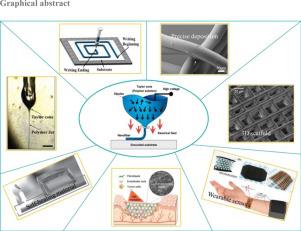当前位置:
X-MOL 学术
›
Nano Today
›
论文详情
Our official English website, www.x-mol.net, welcomes your
feedback! (Note: you will need to create a separate account there.)
Electro-Hydrodynamic Direct-Writing Technology toward Patterned Ultra-Thin Fibers: Advances, Materials and Applications
Nano Today ( IF 13.2 ) Pub Date : 2020-12-01 , DOI: 10.1016/j.nantod.2020.100942 Zhenfang Zhang , Haijun He , Wanlin Fu , Dongxiao Ji , Seeram Ramakrishna
Nano Today ( IF 13.2 ) Pub Date : 2020-12-01 , DOI: 10.1016/j.nantod.2020.100942 Zhenfang Zhang , Haijun He , Wanlin Fu , Dongxiao Ji , Seeram Ramakrishna

|
Abstract Fibers, having a large aspect ratio, have become an essential material in human life since the dawn of civilization. Lots of efforts have been made in controlling the fine structure and architecture of fibers for diverse applications. However, great technological challenges remain on patterning fibers with diameters down to tens of nanometers into the desired structure through conventional methods. Electro-hydrodynamic direct-writing (EHDDW) technology shows great potential in depositing the highly aligned micro/nanofibers in a noncontact, direct, and controllable manner which can achieve a real-time adjustment and individually accurate control even on flexible, curved substrates. In this review, beginning with a brief introduction to the history of EHDDW, we first discuss its basic principle and typical apparatus. We continue with a highlight of its rise over the past decades as a powerful technology for the production of nanofibers with versatile compositions and structures. Afterward, we summarize the applications of such “controlled” nanofibers, including their uses as “smart” wearables, energy harvesting/conversion/storage components, and biomedical scaffolds. In the end, we discuss the opportunities and the development directions for this promising area.
中文翻译:

面向图案化超薄纤维的电动流体动力学直写技术:进展、材料和应用
摘要 纤维具有较大的纵横比,自文明之初就成为人类生活中必不可少的材料。在控制用于各种应用的纤维的精细结构和结构方面已经做出了很多努力。然而,通过传统方法将直径低至数十纳米的纤维图案化成所需结构仍然存在巨大的技术挑战。电流体动力直写 (EHDDW) 技术在以非接触、直接和可控的方式沉积高度对齐的微/纳米纤维方面显示出巨大的潜力,即使在柔性弯曲基板上也可以实现实时调整和单独精确控制。在这篇综述中,首先简要介绍 EHDDW 的历史,首先讨论其基本原理和典型装置。我们继续强调它在过去几十年中作为生产具有多功能成分和结构的纳米纤维的强大技术而崛起的亮点。然后,我们总结了这种“受控”纳米纤维的应用,包括它们作为“智能”可穿戴设备、能量收集/转换/存储组件和生物医学支架的用途。最后,我们讨论了这个有前景的领域的机会和发展方向。
更新日期:2020-12-01
中文翻译:

面向图案化超薄纤维的电动流体动力学直写技术:进展、材料和应用
摘要 纤维具有较大的纵横比,自文明之初就成为人类生活中必不可少的材料。在控制用于各种应用的纤维的精细结构和结构方面已经做出了很多努力。然而,通过传统方法将直径低至数十纳米的纤维图案化成所需结构仍然存在巨大的技术挑战。电流体动力直写 (EHDDW) 技术在以非接触、直接和可控的方式沉积高度对齐的微/纳米纤维方面显示出巨大的潜力,即使在柔性弯曲基板上也可以实现实时调整和单独精确控制。在这篇综述中,首先简要介绍 EHDDW 的历史,首先讨论其基本原理和典型装置。我们继续强调它在过去几十年中作为生产具有多功能成分和结构的纳米纤维的强大技术而崛起的亮点。然后,我们总结了这种“受控”纳米纤维的应用,包括它们作为“智能”可穿戴设备、能量收集/转换/存储组件和生物医学支架的用途。最后,我们讨论了这个有前景的领域的机会和发展方向。











































 京公网安备 11010802027423号
京公网安备 11010802027423号